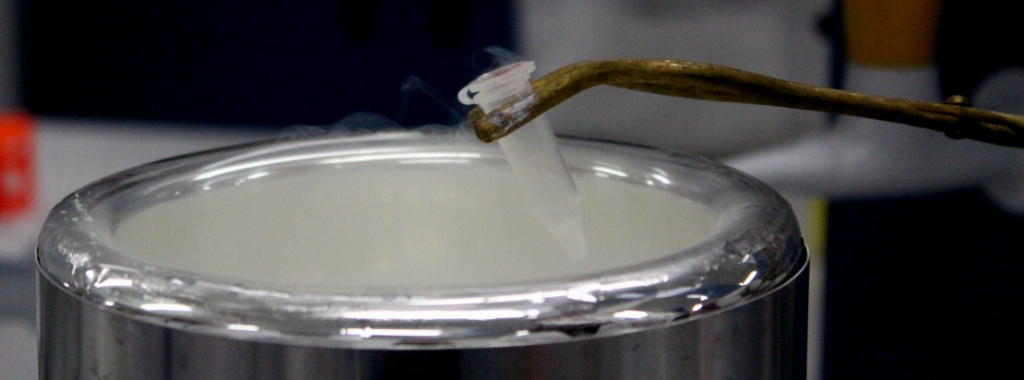Team:Macquarie Australia/Protocols/Making competent Cells
From 2012.igem.org
(→Methods:) |
(→Methods:) |
||
| (12 intermediate revisions not shown) | |||
| Line 1: | Line 1: | ||
{{:Team:Macquarie_Australia/Template/MQ12}} | {{:Team:Macquarie_Australia/Template/MQ12}} | ||
| - | == | + | ==Competent cell protocol== |
| - | + | ||
| + | [[File:nitrogen.jpg|500px|thumb|left|Competent cells were reduced to -80C via liquid nitrogen]] | ||
====Methods:==== | ====Methods:==== | ||
| - | + | <p> | |
| - | + | In order to produce competent cells for our transformations, we used a modified version of the protocol developed by Inoue et al (1990). | |
| - | + | </p> | |
| - | + | <p> | |
| - | + | We grew cultures of E. coli cells (Top10 and BL21 strains) overnight with shaking at room temperature in SOB media, to mid-log phase to an A600 of ~0.5. They were then chilled on ice and pelleted in the Sigma centrifuge at ~2500g for about seven minutes at 4°C. We then discarded the supernatant and placed the cells back on ice, before resuspending them in 1 to 5mL of ice-cold TB buffer and using additional buffer to bring the volume up to about one-fifth of the original volume. This solution was incubated on ice for ten minutes, before we centrifuged it again and discarded the supernatant. Again, we resuspended the cells in about one-twentieth of the original culture volume of ice-cold TB buffer. We then distributed 930µL of this cell solution into a number of 1.5mL microcentrifuge tubes (that had been pre-chilled on ice) and added 70µL of DMSO to each. Each tube was gently mixed and placed on ice. These were then divided into smaller aliquots (100µL) and frozen for later use. | |
| - | + | </p> | |
| - | + | <p> | |
| - | + | Details of the original protocol are located in Inoue et al. (1990) "High efficiency transformation of Escherichia coli with plasmids", ''Gene'', vol. 96, pp. 23-38. | |
| - | + | ||
| - | + | ||
| - | + | ||
Latest revision as of 00:33, 4 September 2012
Competent cell protocol
Methods:
In order to produce competent cells for our transformations, we used a modified version of the protocol developed by Inoue et al (1990).
We grew cultures of E. coli cells (Top10 and BL21 strains) overnight with shaking at room temperature in SOB media, to mid-log phase to an A600 of ~0.5. They were then chilled on ice and pelleted in the Sigma centrifuge at ~2500g for about seven minutes at 4°C. We then discarded the supernatant and placed the cells back on ice, before resuspending them in 1 to 5mL of ice-cold TB buffer and using additional buffer to bring the volume up to about one-fifth of the original volume. This solution was incubated on ice for ten minutes, before we centrifuged it again and discarded the supernatant. Again, we resuspended the cells in about one-twentieth of the original culture volume of ice-cold TB buffer. We then distributed 930µL of this cell solution into a number of 1.5mL microcentrifuge tubes (that had been pre-chilled on ice) and added 70µL of DMSO to each. Each tube was gently mixed and placed on ice. These were then divided into smaller aliquots (100µL) and frozen for later use.
Details of the original protocol are located in Inoue et al. (1990) "High efficiency transformation of Escherichia coli with plasmids", Gene, vol. 96, pp. 23-38.
 "
"





